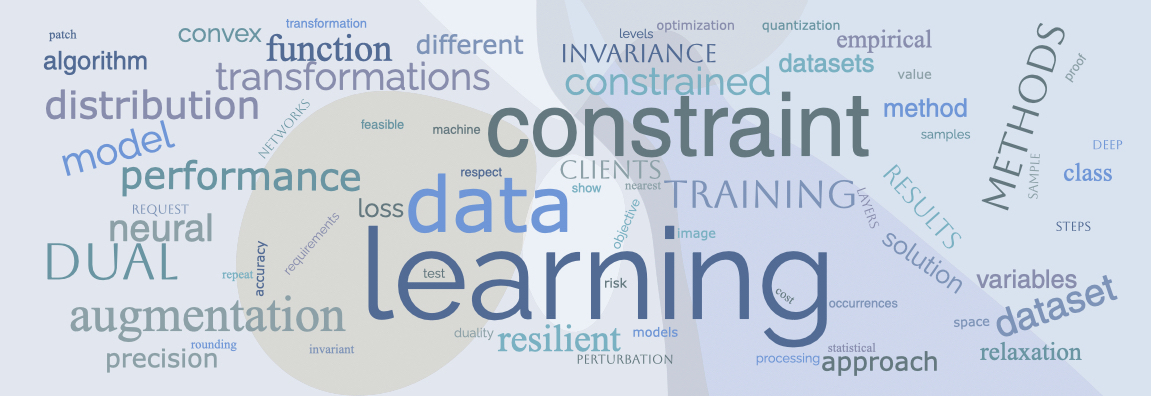Bio
I'm a final year Ph.D. student at the University of Pennsylvania, advised by Prof. Alejandro Ribeiro, broadly interested in machine learning and optimization. The focus of my current research is adapting pre-trained generative models under constraints. The core tenet is that, in many scenarios, constrained optimization tools can provide a principled approach to navigate trade-offs between conflicting requirements. Previously I worked on constrained machine learning methods tackling problems ranging from time series forecasting, invariance and data augmentation to model quantization and federated learning.
I earned my BSc. in Electrical Engineering from Udelar in Montevideo, Uruguay, which is my hometown. During my time there, I worked on various ML applications including environmental sound monitoring, image restoration, and genome enabled prediction. During the summer of 2025, I interned at Microsoft 365 Copilot, focusing on fine-tuning reasoning models. I interned at Amazon in the summer of 2024, where I worked on adapting large scale multi-modal classification systems under distribution shift using conformal methods. I'm also organizing the first Workshop on Constrained Optimization for Machine Learning (COML) at Neurips 2025.
Publications
Full list of publications on Google Scholar.
Alignment of large language models with constrained learning
Botong Zhang, Shuo Li, Ignacio Hounie, Osbert Bastani, Dongsheng Ding, Alejandro Ribeiro
Neurips 2025 (to appear).
Composition and Alignment of Diffusion Models using Constrained Learning
Shervin Khalafi, Ignacio Hounie, Dongsheng Ding, Alejandro Ribeiro
Neurips 2025 (to appear).
Distilling On-device Language Models for Robot Planning with Minimal Human Intervention
Zachary Ravichandran, Ignacio Hounie, Fernando Cladera, Alejandro Ribeiro, George J Pappas, Vijay Kumar
CORL 2025.
Feasible Learning
Juan Ramirez, Ignacio Hounie, Juan Elenter, Jose Gallego-Posada, Meraj Hashemizadeh, Alejandro Ribeiro, Simon Lacoste-Julien
AISTATS 2025.
Loss Shaping Constraints for Long-Term Time Series Forecasting
Ignacio Hounie, Javier Porras-Valenzuela, Alejandro Ribeiro
ICML 2024.
Resilient Constrained Learning
Ignacio Hounie, Alejandro Ribeiro, Luiz F. O. Chamon
NeuRIPS 2023.
Automatic Data Augmentation via Invariance Constrained Learning
Ignacio Hounie, Luiz F. O. Chamon, Alejandro Ribeiro
ICML 2023.
Neural Networks with Quantization Constraints
Ignacio Hounie, Juan Elenter, Alejandro Ribeiro
ICASSP 2023.
Image inpainting using patch consensus and DCT priors.
Ignacio Ramírez Paulino, Ignacio Hounie
Image Processing On Line 2021.
DCASE-models: a Python library for computational environmental sound analysis using deep-learning models
Pablo Zinemanas, Ignacio Hounie, Pablo Cancela, Frederic Font Corbera, Martín Rocamora, Xavier Serra
DCASE 2020.
Self-give: Associative thinking from limited structured knowledge for enhanced large language model reasoning
Jiashu He, Jinxuan Fan, Bowen Jiang, Ignacio Hounie, Dan Roth, Alejandro Ribeiro
Under review.
Infinity Search: Approximate Vector Search with Projections on q-Metric Spaces
Antonio Pariente, Ignacio Hounie, Santiago Segarra, Alejandro Ribeiro
Under review.
Alignment of large language models with constrained learning
Botong Zhang, Shuo Li, Ignacio Hounie, Osbert Bastani, Dongsheng Ding, Alejandro Ribeiro
Neurips 2025 (to appear).
Composition and Alignment of Diffusion Models using Constrained Learning
Shervin Khalafi, Ignacio Hounie, Dongsheng Ding, Alejandro Ribeiro
Neurips 2025 (to appear).
Distilling On-device Language Models for Robot Planning with Minimal Human Intervention
Zachary Ravichandran, Ignacio Hounie, Fernando Cladera, Alejandro Ribeiro, George J Pappas, Vijay Kumar
CORL 2025.
LoRTA: Low Rank Tensor Adaptation of Large Language Models
Ignacio Hounie, Charilaos Kanatsoulis, Arnuv Tandon, Alejandro Ribeiro
Under review.
Feasible Learning
Juan Ramirez, Ignacio Hounie, Juan Elenter, Jose Gallego-Posada, Meraj Hashemizadeh, Alejandro Ribeiro, Simon Lacoste-Julien
AISTATS 2025.
Loss Shaping Constraints for Long-Term Time Series Forecasting
Ignacio Hounie, Javier Porras-Valenzuela, Alejandro Ribeiro
ICML 2024.
Resilient Constrained Learning
Ignacio Hounie, Alejandro Ribeiro, Luiz F. O. Chamon
NeuRIPS 2023.
Automatic Data Augmentation via Invariance Constrained Learning
Ignacio Hounie, Luiz F. O. Chamon, Alejandro Ribeiro
ICML 2023.
Neural Networks with Quantization Constraints
Ignacio Hounie, Juan Elenter, Alejandro Ribeiro
ICASSP 2023.
Image inpainting using patch consensus and DCT priors.
Ignacio Ramírez Paulino, Ignacio Hounie
Image Processing On Line 2021.
DCASE-models: a Python library for computational environmental sound analysis using deep-learning models
Pablo Zinemanas, Ignacio Hounie, Pablo Cancela, Frederic Font Corbera, Martín Rocamora, Xavier Serra
DCASE 2020.
Paco and paco-dct: Patch consensus and its application to inpainting
Ignacio Ramírez Paulino, Ignacio Hounie
ICASSP 2020.
Something old, something new, something borrowed: Evaluation of different neural network architectures for genomic prediction.
Maria Inés Fariello, Lucía Arboleya, Diego Belzarena, Leonardo De Los Santos, Juan Elenter, Guillermo Etchebarne, Ignacio Hounie, Gabriel Ciappesoni, Elly Navajas, Federico Lecumberry
Plant & Animal Genome Conference 2023
Graph Neural Networks for genome enabled prediction of complex traits.
Ignacio Hounie, Juan Elenter, Guillermo Etchebarne, María Inés Fariello, Federico Lecumberry
Probabilistic Modeling in Genomics 2021.
On two dimensional mappings of SNP marker data and CNNs: Overcoming the limitations of existing methods using Fermat distance.
Juan Elenter, Guillermo Etchebarne, Ignacio Hounie, María Inés Fariello, Federico Lecumberry
Probabilistic Modeling in Genomics 2021.

A word cloud representation of my most recent publications, for aesthetic purposes only.
Vitæ
Full Resume in PDF.
Miscelaneous
A Constrained Learning Evangelization.
For the skeptical reader who may harbor reasonable doubts about the relevance of this line of work to their own, let me share my two cents on it. If you're looking for a more thorough, less opinionated and hopefully more convincing argument, I encourage you to delve into our papers, attend our talks, or simply reach out :)
Let’s start with why.
Machine Learning (ML), as we know it, is all about attaining objectives. The pluralization of the word objectives is not coincidental. More often than not, and as in any other system that we build and design, these objectives comprise several aspects or metrics that have to be accounted for. This also entails desiderata that is more naturally expressed as requirements – from social, business and engineering perspectives –. That is, a distinction emerges between performance objectives- what we want a model to be as good as possible at - and critical constraints that we need to be enforced in deployment. Most approaches require the daunting task of heuristically adjusting weights, learning curricula or schedules to integrate requirements in ML pipelines. More importantly, they provide little guarantees about satisfying each individual requirement. This should be relatable to everyone that had to tune weights for conflicting objectives or regularization coefficients.
Life is complex and multi-dimensional, why would ML be any different?
ML is also, essentially, an optimization problem. Thus, it would be naive to ignore the vast knowledge about constrained optimization that has been developed (mostly) over the last century. We are not discovering the wheel here; the ML and optimization fields – if one is inclined to believe that these are two entirely separate communities – have nurtured each other for years. Surprisingly, in the deep learning era, incredibly powerful algorithmic tools from constrained optimization have received little attention from both practitioners and researchers. Instead, the focus has been predominantly on unconstrained optimization.
Constrained Optimization methods have been relegated to old and well studied and more tractable problems and we have made all this progress – seemingly – without them.
It comes as no surprise that upon examining various existing ML techniques, we discover that many, despite their initial motivations, end up tackling constrained learning problems. Rather than being discouraging, this suggests that constrained learning offers an expressive framework that can provide principled and interpretable approaches to several relevant problems. By unifying these existing techniques, which are often highly domain and application dependent, we also aim to develop more general tools. I do so in the belief that we will once again learn the bitter lesson: in the long run, the more general approach prevails.
(Only) (Some) (Current) Applications
This is a biased, incomplete, unordered, and by no means representative enumeration of applications (with some references). However, I’ve decided to put it together just to illustrate that Constrained Learning already has a myriad of applications.
- Heterogeneous Federated Learning
- Robustness
- Safety
- Reinforcement Learning
- Active Learning
- Continual Learning
- Learning with Structural Priors
- Diffusion Models
Still Lots to Explore!
What sets Constrained Learning apart from other Constrained Optimization problems is that objectives and requirements are statistical. In other words, data – and let’s not forget computation – play crucial roles in defining requirements and enabling their fulfillment. Fueled by impressive achievements in the field of ML, both the data and models it deals with have grown exponentially more complex. This presents us with new challenges and possibilities which, if you have reached this point, you probably agree to some extent that are worth exploring.
